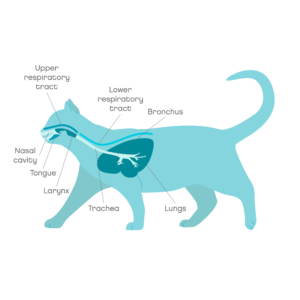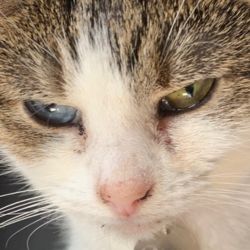Cat flu is a viral illness that causes similar symptoms to human flu. This is a common and contagious disease that can also result in eye problems. In healthy cats, it is usually not serious, unlike in kittens and adult cats with underlying illnesses.
Cat flu is also called Feline Upper Respiratory Disease Complex. Cats can catch this virus through direct contact with an infected cat or contaminated objects. The illness is typically brief, lasting from 7 to 21 days. Yet, some cats can develop life-long or recurrent signs.
Overview
What is cat flu?
Cat flu is a general term for a disease with symptoms that involve the upper respiratory tract (nose, mouth, throat) and eyes. These include sneezing, a snotty nose, and weepy eyes.
Cat flu can be caused by two types of viruses (calcivirus and herpes virus) and two types of bacteria (Bordetella bronchiseptica and Chlamydophila felis).
Cats infected with herpes virus become lifetime carriers and have symptoms of cat flu on and off throughout their life.
This disease spreads very easily, usually through sneezing. Cat flu carriers may still spread the disease, despite looking healthy.
There are vaccines available. This is not a guaranteed defence but will make them more resistant to the disease.
Cat flu is usually viral, meaning that antibiotics won’t be effective in most cases.
Since kittens can be severely affected, we recommend you contact a vet if you suspect they have cat flu.
Bordetella bronchiseptica is the bacteria that causes kennel cough in dogs.

Symptoms
Symptoms of cat flu
- Sneezing
- Snotty nose
- Weepy eyes
- Red eyes
- Squinting eyes
- Coughing
- Fever
- Difficulty breathing
- Noisy breathing
- Lack of appetite
- Difficulty eating
- Tiredness
Risk
Is your cat at risk?
Young cats, elderly cats, and cats with other illnesses can be more prone to showing signs of disease. This is mainly because their immune system isn’t very strong.
Cats living in a high population density, such as cat shelters or multi-cat households, can also be more likely to catch this.
Before taking your cat to a cattery, make sure they are up to date with their vaccinations.
If you are a dog owner too and your dog has been diagnosed with kennel cough, it is better to keep cat and dog separate.
Diagnosis
How is cat flu diagnosed?
Vets usually diagnose cat flu based on:
- History taking
- Cat’s symptoms
- Hands-on examination
On some occasions, vets may need to do further testing, such as:
- Dye test on the eye
- Tear production test
- Testing for viruses
- Bacterial culture and sensitivity testing
- Blood tests to check for other illnesses affecting the body
- Taking x-rays
Vet treatment
What’s the treatment for cat flu?
Most cases of cat flu are mild and easily managed with medication to ease symptoms.
There is no cure for cat flu caused by herpes virus, but there are many things that can reduce the symptoms and help the body fight the infection.
The treatment may differ in mild and severe cases and may include some of the following:
- Eye drops or ointments
- Anti-inflammatories
- Oral antiviral medications
- Antibiotics (if bacterial infections are present or pneumonia is suspected)
- Appetite stimulants
- Medication that stimulates the immune system
- Humidifiers or nasal saline drops to help with nasal congestion
Home treatment
How to look after a cat with flu at home
Following your vet’s treatment recommendations
Clean their eyes and nose
- This will help them smell their food and breathe more easily.
- Use cotton wool soaked in warm water to wipe any discharge from their eyes and nose.
Help them breathe better
- Place them in a steamy room (i.e. the bathroom while you’re showering). This will help break down some of the thick mucus in their airways, allowing them to breathe better.
- Or you may use a humidifier or nebulizer to clear the nasal passage.
Help them eat
- Add small pieces of warm, smelly food to their meals (e.g. sardines, anchovies, tuna, chicken).
Reduce stress
- A low-stress environment is very important.
- Cats are very sensitive to stress, which can lead to a recurrence of the disease.
What to expect if your pet has cat flu?
What is the outcome for a cat with cat flu?
Most cats respond well and quickly to medical treatment and live normal lives.
Some cats may need extra medication or assistance to help with flare-ups if they happen often or are very severe.
How long will cat flu be contagious?
Cats can remain infectious for up to 3 weeks after showing signs of illness.
Do not allow these pets to interact with other cats, especially kittens during this time.
What happens if cat flu is left untreated?
Viral diseases can progress and allow bacterial infections to develop. This can lead to complications such as pneumonia, much like in human flu.
Can cat flu have long-term effects?
Sometimes they can be left suffering from a permanently runny nose, called chronic rhinitis.
Cats that have repeated eye infections and corneal ulcerations may develop permanent scarring of the surface of the eye.
In severe cases, some cats will suffer from ongoing inflammation of the mouth and gums – gingivitis. This requires medical treatment and, occasionally, tooth extractions.
Periods of stress may bring on repeated episodes of cat flu if your cat is a lifelong carrier.
Prevention
Tips on how to prevent cat flu
Vaccination
- Vaccines can prevent infection or prevent cats from becoming lifelong carriers.
- When cats are already infected, vaccines will help reduce the severity of the signs of disease.
Reduce stress
- To help prevent the recurrence of disease in lifelong carriers.
Provide excellent nutrition
- To help support a strong immune system.
When to worry
When do you need to call the vet?
If your cat shows any of the following signs, call your local vet now:
- Squinting or being unable to hold the eye(s) open
- Difficulty breathing, open-mouth breathing (cats don’t pant, this is an emergency)
- Failure to improve despite treatment
If your cat is showing one or more of the following signs, call us at Joii:
- Discharge from the eyes and nose
- Eye redness or squinting
- Sneezing
- Nasal congestion
- Coughing or wheezing
- Lack of appetite
- Stress in the household









